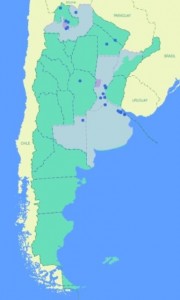- What’s the difference between pluots and plumcots? By the guy who wrote the book.
- ACIAR publication on village chickens, and another. Thanks, DAD-Net.
- Modeling the axolotl, the edible Mexican salamander, before it’s too late.
- Artisanal fishing data. Via.
- USDA looking to expand its fruit collection to cope with climate change. NOt the only ones, I imagine.
- Danes stamp on allotments. No, wait. Allotments on Danish stamps.
- Aussies find genetic marker for hornless cattle that will jump on barbie by themselves.
- Breeding better Artemisia annua.
- The diversity of farmer-managed aquatic systems in SE Asia.
- 15% of angiosperm speciation events are accompanied by ploidy increase. Much more in domesticated species, I bet.
Snorkel rice
![]() Yoko Hattori and colleagues report in Nature 1 that they have identified two genes involved in the awesome elongation of deep water rice; the type of rice that can grow in several meters deep water. The genes, baptized SNORKEL1 and SNORKEL2, can now be identified with molecular markers and crossed into popular rice varieties. The BBC has a nice video comparing — I assume — genetically otherwise nearly identical rice varieties with and without the genes.
Yoko Hattori and colleagues report in Nature 1 that they have identified two genes involved in the awesome elongation of deep water rice; the type of rice that can grow in several meters deep water. The genes, baptized SNORKEL1 and SNORKEL2, can now be identified with molecular markers and crossed into popular rice varieties. The BBC has a nice video comparing — I assume — genetically otherwise nearly identical rice varieties with and without the genes.
The avid reader will remember the runner-up entry in The Competion about the sub-1 gene 2, that is used by IRRI to make rice flood-proof. Some of these new sub-1 varieties, such as Swarna-sub1 are already grown by farmers in India and Bangladesh.
Interestingly, sub-1 does the very opposite of SNORKEL. Sub-1 shuts the plant off to stop elongation, so that it saves its energy, and can recover later. This works great with flash floods if the water recedes after a week or two. But if the water stays for longer than that, the crop dies. With stagnant deep water, a variety with the SNORKEL gene could be a better bet.
If farmers know beforehand that the water is going to be very deep (because it happens most years), they probably already plant deep water varieties (or plant later or do some other smart thing). Deep water rice is somewhat in decline, because of low yield, but it is grown on a very large area, probably about 3.5 million ha worldwide, mostly in India, Bangladesh, Myanmar, Thailand, Indonesia, Vietnam and Cambodia.
However, if flooding is rare it could be more profitable, though risky, to plant other than deep-water varieties. For their earliness, yield, quality, or what not. Adding either the sub-1 or the SNORKEL gene 3 to those varieties would be an insurance policy for flood years. But which gene to choose? And in what variety? And where to grow it? Not an easy question, but we have been trying to answer it.
Mapping Argentinian pests and diseases
The Instituto Nacional de Tecnología Agropecuaria in Argentina has a new online pest and disease atlas out. It’s in Spanish, but pretty intuitive to use. You can search by host or by pest/disease organism. And you get a bunch of references, descriptive notes, photos and a map, albeit a static one — not sure how updating will be done. Below is the distribution of Setosphaeria turcica, the causal agent of Northern Leaf Blight in corn, for example. Would be interesting to mash this kind of thing up with the distribution of tolerant material. Must look into that. And of course one could do some climate change prediction modeling too. Thanks to IIALD.

Nibbles: Gardening, Maple syrup, Farming and conservation, Late blight, Urban guerrilla, Bizarre produce, Russian food, Aquaculture, Heirloom apples, Turkish medicinal plants, Bee-eating hornets
- NY Botanical Garden launches summer Edible Garden celebration.
- Thingy for getting more syrup out of maples invented.
- Farmer floods his fields on purpose.
- Insights into tomato late-blight resistance. Do try and keep up!
- A very English guerrilla gardener.
- Pictures of weird fruits and vegetables.
- Russian starters. Uhm, I spot a trend.
- The future of aquaculture: giant robotic roaming cages.
- Saving California’s Sebastopol Gravenstein apple.
- “Zeytinburnu Medicinal Plant Garden, opened in 2005, is Turkey’s first and only medicinal plant garden.”
- Something else has it in for bees: Chinese hornets.
Nibbles: Seed travels, Carotenoids in cucumbers, Tea and hibiscus, Sea level rise, Tewolde on climate change, SPGRC
- After a year’s travel in search of seeds, Adam Forbes turns in his report.
- The genetics of orange-fleshed cucumbers elucidated.
- Tea and hibiscus booze.
- Video of honey harvesting.
- Maps of sea level rise. All somewhat unsatisfying, somehow.
- “Because we are poor, we shall suffer first but, ultimately, we shall all die together.”
- SADC Plant Genetic Resources Centre (SPGRC) director Paul Munyenyembe does the public awareness thing.